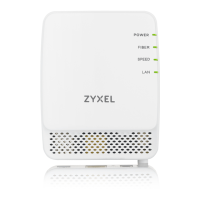Chapter 25 Multicast
OLT2406 User’s Guide
202
25.3 Multicast Setting
Click Advanced Application > Multicast > Multicast Setting link to display the screen as shown. See
Section 25.1.2 on page 197 for more information on multicasting.
Dropped By This column displays how many multicast queries that have been dropped in this VLAN due to
the following reasons:
MaxGroup: the number of multicast groups the ports in this VLAN have joined exceeds the
per-port Max Group Limit configured in the Advanced Application > Multicast > Multicast
Setting screen.
Filter: the VLAN is not allowed to join a multicast group in a multicast join message the ports in
this VLAN received. You can configure the filtering list in the Advanced Application > Multicast
> Multicast Setting screen.
MVR: the receiving ports in this VLAN are not the receiver ports in the MVR multicast VLANs.
You can configure the MVR settings in the Advanced Application > Multicast > Multicast
Setting > MVR screen.
Others: reasons other than the ones described above, such as the OLT has insufficient
memory.
IGMP Per VLAN Transmit Counter
This section displays outgoing multicast traffic statistics per VLAN network.
Report Out This column displays how many V1, V2, and V3 multicast join messages and multicast Leave
messages sent on a VLAN network. V1, V2, and V3 means IGMP versions 1, 2 and 3.
VID This field displays the multicast VLAN ID.
Query Out This column displays how many valid V1, V2, and V3 multicast queries sent on a VLAN network.
IGMP Per Port Querier Source IP
Index This is the index number of the entry.
Port The number of a port which has received multicast queries.
VID The VLAN ID to which the received multicast queries belong.
Querier Source
IP
The IP address of the device which sent the multicast queries.
Table 69 Advanced Application > Multicast
LABEL DESCRIPTION

